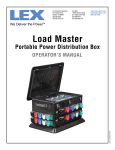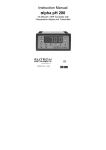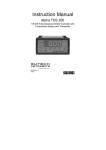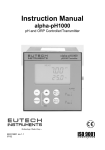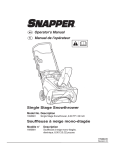Download EUTECH INSTRUMENTS ALPHA CON 500 2-WIRE TRANSMITTER Operating instructions
Transcript
EUTECH INSTRUMENTS αlpha-pH800 pH and ORP Controller/Transmitter Operating Instructions 68X216813 03/99 Preface Thank you for purchasing the αlpha-pH800 series pH/ORP controller/transmitter. This manual serves to explain the use of the αlpha-pH800 series pH/ORP controller/transmitter. The manual functions in two ways, firstly as a step by step guide to help the user operate the instrument. Secondly, it serves as a handy reference guide. This instruction manual is written to cover as many anticipated applications of the αlpha-pH800 pH/ORP controller/transmitter. If you have doubts in the use of the instrument, please do not hesitate to contact the nearest Eutech Instruments’ Authorised Distributor. The information presented in this manual is subject to change without notice as improvements are made, and does not represent a commitment on part of Eutech Instruments Pte Ltd. Eutech Instruments cannot accept any responsibility for damage or malfunction of the unit due to improper use of the instrument. Copyright 1999 Eutech Instruments Pte Ltd. Version 1.0. All rights reserved. Eutech Instruments Pte Ltd. Blk 55, Ayer Rajah Crescent #04-14/24, Singapore 139 949. Tel: (65) 778 6876; Fax: (65) 773 0836; e-mail: [email protected]; Home page: http://www.eutechinst.com TABLE OF CONTENTS 1 INTRODUCTION................................................................................................ 1 1.1 Description of Unit.................................................................................... 1 1.2 Applications................................................................................................ 2 2 ASSEMBLY AND INSTALLATIONS ............................................................. 3 2.1 Measurement and Control System........................................................ 3 2.2 Unit Dimensions ....................................................................................... 3 3 ELECTRICAL CONNECTIONS....................................................................... 4 3.1 Connection Diagram................................................................................ 4 3.2 Back Panel................................................................................................ 6 4 OVERVIEW....................................................................................................... 8 4.1 Keypad and Display................................................................................. 8 Function Groups................................................................................................... 9 4.2 Control Concept ....................................................................................... 9 5 MEASUREMENT............................................................................................ 10 5.1 Display in Measurement mode ............................................................ 10 6 CALIBRATION............................................................................................... 11 6.1 pH Calibration......................................................................................... 11 6.2 ORP – mV Calibration........................................................................... 13 7 ADVANCED SET UP MODE......................................................................... 14 7.1 Electrode Offset (OFS) sub-function................................................... 14 o 7.2 Setting temperature (Set C) sub-function ......................................... 15 7.3 Control Relay A/Control Relay B (SP1/SP2) sub-function............... 18 7.4 Configuration (ConF) sub-function ...................................................... 22 7.5 Calibration (CAL) sub-function............................................................. 23 8 TECHNICAL SPECIFICATIONS................................................................... 24 9 ACCESSORIES ............................................................................................... 25 10 GENERAL INFORMATION....................................................................... 25 10.1 Warranty.................................................................................................. 25 10.2 Packaging ............................................................................................... 25 10.3 Return of Goods..................................................................................... 26 10.4 Guidelines for Returning Unit for Repair ............................................ 26 11 APPENDICES.............................................................................................. 27 11.1 Appendix 1 .............................................................................................. 27 11.2 Appendix 2 .............................................................................................. 28 11.3 Appendix 3 .............................................................................................. 29 1 1.1 INTRODUCTION Description of Unit Thank you for purchasing Eutech’s ¼ DIN alpha-800 series pH/ORP process controllers. This unit is used for measuring either pH or ORP parameter one at a time, and the operational mode is switchable from the menu. You can use this unit to measure pH or ORP with limit control. This controller has many user-friendly and safety features which include: • Menu-driven program that simplifies set-up • Built-in non-volatile memory backup to ensure that calibration and other information are not erased if power supply fails • Push-button two-point calibration and electrode offset adjustment from the keypad • Automatic temperature compensation (ATC) • Manual temperature compensation setting without the ATC probe, with independent setting for calibration and process temperature • 0 to 2000 second time delay adjustment on all relays – minimise false alarms • Separately adjustable high and low set point hysteresis (dead bands) prevent chattering of relays around the set points • Asymmetrical/symmetrical input for pH/ORP operation • Large dual display LCD for easy reading with clear multiple annunciators, alarm status, operational and error messages • Two switching contacts as set-point triggering relays • Hold function freezes output current (4/20mA) and control relays • LED indicators signal control activities to monitor controller status from a distance • Protection against electromagnetic interference – Input and output are free from external inference 1 1.2 Applications Use this controller in panel mounted enclosures for applications such as water treatment and monitoring, galvanic-decontamination, chemical processing food processing, clean or waste water control and neutralisation process. 2 2 2.1 ASSEMBLY AND INSTALLATIONS Measurement and Control System A typical measurement system consists of: • a pH/ORP process controller • a pH/ORP combination electrode with integrated or separate temperature sensor Pt 100/1000, • an immersion, flow or process assembly with or without a potential matching pin (PMP) • a final control element such as pump or valve • a recorder Flow Assemb ly pH Controller Chart Recorder Process Assembly with Electrode Measurement Cable Power Mains (220/110 VAC) 2.2 Unit Dimensions Flat Gasket (1mm) (To be Inserted By Customer) Note: The Taped Corners Have to Be On Top 92 + 0.5 96 92 56 32 92 + 0.5 max. 45 max. 175 Mounting Cut-Out The field-tested control panel housing is 96 x 96 mm; with protection class IP 54 (front). 3 3 ELECTRICAL CONNECTIONS 3.1 Connection Diagram pH S/ S/ V 18 BNC 19 20 21 22 PE/S Potential Matching Pin (PMP) Pt 100 Relay A Power Mains Signal Input pH/ORP Hold Input Relay B Signal Output pH mA + 3 2 1 4 5 6 7 8 9 10 11 12 13 14 15 PE/S AC: L N PE * ) indicated contact positions are for currentless conditions 4 16 17 Temp. PE N L pH S 0 / PA 3 1 22 2 21 20 19 18 S BNC Symmetrical high-impedance connections Measuring Cable Potential Matching Pin (PM) pH Combination Electrode Temp. PE N L pH S 0 / PA 3 2 1 22 21 20 19 18 BNC Asymmetrical connections Measuring Cable Potential Matching Pin (PM) pH Combination Electrode 5 3.2 Back Panel The back panel consists of two connectors. The first connector is the 17-way PCB edge connector and the other is the 5-way connector. Connection for the 17-way screw terminals (from left to right): 1.AC mains live wire 2.AC mains neutral wire 3.AC mains protective earth wire 4.Low set relay resting position (NC) 5.Low set relay common 6.Low set relay working position (NO) 7.High set relay resting position (NC) 8.High set relay common 9.High set relay working position (NO) 10.No connection 11.No connection 12.No connection 13.Hold function switch terminal 1 14.Hold function switch terminal 2 15.No connection 16.4 - 20 mA for -ve connection 17.4 - 20 mA for +ve connection Connections for the 5-way screw terminals: 18. Pt100/Pt1000 lead 1 terminal 19. Pt100/Pt1000 sense lead terminal 20. Pt100/Pt1000 lead 2 terminal Note: If using a two-wire RTD, short terminal 19 to terminal 18. Pt 100/Pt 1000 is selectable via an internal jumper. Factory default is Pt100. See Appendix 1 for directions on switching the RTD type. 21. pH/ORP (potential matching pin) 21. pH/ORP (shield) 6 Pt100/ Pt1000 0V/ PAL S/ RELAY B NC FUSE 250VAC 100mA (F) RELAY A L N PE 7 NC NC HOLD NC - + 4 OVERVIEW 4.1 Keypad and Display 4.1.1 Keypad • Perform rapid 2-point calibration and view electrode status • Allows entry to Set up mode • Select individual functions within the function group of Set up mode • Store input data in the Set up mode • Start calibration in the calibration mode • Select various function groups in the Set up mode. • Set parameters and numerical values in sub functions of Set up mode If pressed continuously, the setting speed increases • Return to the Measurement mode when both keys are pressed together 4.1.2 Display The LCD display features two numerical displays that show status messages and measured values for easy, quick reference. The display provides shorttext information for setting parameters and configuration. SETUP READY HOLD • • • • MEAS: Measurement mode SETUP: Set-up mode of function groups pH CAL: Calibration mode of pH/ORP READY: Comes on after a successful C 25.0 ATC calibration • HOLD: Relay position and current output are frozen • ATC: Comes on in the ATC mode. Disappears in the Manual temperature Compensation mode. “ATC” flashes if the temperature probe is faulty in its ATC mode • Display for RELAY A/B. Green LED indicates measured value within limit while RED LED indicates measured value outside limit. MEAS CAL CON 7.00 o • Alarm display if limit value overshoot or the ATC probe fails. 8 Function Groups The main function and sub-function groups are organised in a matrix format for configuration and selection of parameters. The main function groups are: 1) Offset adjustment (OFS) o 2) Temperature Measurement / compensation settings (Set C) 3) Control relay 1 configuration (SP1) 4) Control relay 2 configuration (SP2) 5) Configuration (ConF) 6) Calibration (CAL pH) 4.2 Control Concept The main function and sub-function groups are organised in a matrix format as shown below. These functions can be accessed via the front keypad for configuration and selection of parameters. 9 5 MEASUREMENT 5.1 Display in Measurement mode When the controller is initially powered on, it automatically enters into the Measurement mode after the large dual LCD displays all segments briefly. The upper display shows the measured pH or ORP value, while the lower display shows either the temperature value if the controller is set for pH measurement or “OrP” if it is set for ORP measurement. Annunciators at the right side of the display indicate whether the controller is set for pH or mV measurement.. Similarly annunciators or icons at the top or left side of the display shows the current status of controller, e.g. “MEAS”, “SETUP”, “CAL”, “READY”, etc. In addition, error messages also guide the user in time of any faulty conditions as indicated by “ERR” or icons flashing. 5.1.1 Check electrode performance To read current electrode slope and offset values: 1) Press the CAL key followed by the ENTER key. The upper display shows electrode slope. The lower display reading shows the pH reading at 0 mV. 2) Press the ∆ and ∇ keys to return to Measurement mode. 10 6 CALIBRATION Direct Calibration from the Measurement mode is possible via the CAL key. The Calibration procedure can also be accessed from the Advanced Setup mode. 6.1 pH Calibration This unit features five preset buffer values (1.00, 4.00, 6.86 or 7.00, 9.00, 9.18 and 10.00) for quick, two-point auto calibration. When calibrating this instrument, standard pH buffer solutions must be used. 1) Enter Calibration mode. While in the SETUP Measurement mode, push the CAL key. The upper HOLD and lower display reads “CAL” & “pH”. Push the CAL PH ENTER or CAL key again. The controller displays the electrode status based on the previous calibration. Electrode slope and offset information is CAL READY HOLD displayed. 57.2 6.88 mV pH NOTE: If the display reads “CAL OrP”, see section CAL 7.4 for procedures on how to switch from ORP to pH HOLD readings. 2) 6.96 7.00 Press the ENTER key again to begin pH pH calibration. The “CAL” indicator appears at the top of SETUP display and the buffer indicator appears in the bottom HOLD left corner of the display. The upper display is the on- display indicates the first 4.02 4.00 line pH value as measured by the electrode. The lower CAL pH pH compulsory CAL calibration value, pH 7.00 (or 6.86). READY HOLD 3) Immerse the clean electrode in the buffer solution. In ATC, the temperature probe must also be immersed in the buffer solution. Likewise for 11 59.0 7.00 mV pH symmetrical mode, immerse the potential matching pin in the buffer. 4) Press the ENTER key to start the calibration at pH 7 (or pH 6.86). The electrode indicator and CAL indicator both flash. The controller automatically adjusts the reading to match the buffer value. 5) The lower display will now show its next lower ‘pH’ buffer. Use ∆ and ∇ keys to select the second buffer from one of the 5 remaining preset values. Remove the electrode from the first buffer, wash and then immerse into the second buffer, Once the upper display stabilises press the ENTER key, the electrode and CAL indicator will flash. The controller adjusts the reading to the buffer. 6) After calibrating to a second buffer value, the controller automatically displays electrode slope and offset. The zero point and slope are redetermined after each calibration. 7) Press the ENTER key. If the calibration mode was accessed using the CAL key, the controller will return to the Measurement mode. If the calibration mode was accessed from the Advanced Set-up mode, the controller will return to the sub-function menu. Note: If there is a calibration error, the controller displays “ERR”. If this happens, push both and (escape) to restart the calibration beginning from step 1. Note: When calibrating with manual temperature compensation, the controller automatically changes from the preset process temperature to the calibration temperature. After leaving the Calibration mode, the controller switches back to process temperature (for setting the calibration temperature and the process temperature, see section 7.2.3). 12 6.2 ORP – mV Calibration This mode allows one-point calibration. 1) Enter Calibration mode. While in Measurement mode, push the CAL key. Press the ENTER key. SETUP The upper and lower display reads “CAL OrP”. HOLD CAL OrP Note: If the upper and lower display read “CAL PH”, see section 7.4 for procedures on how to switch from pH to ORP mV readings. CAL 2) Place sensor in the ORP solution. HOLD 3) Press the ENTER key to begin calibration. The 226 mV C “CAL” indicator appears on the display. The upper display shows the current mV output of the electrode without any offset adjustment. 4) Press the ∆ and ∇ keys to adjust the mV value to that of the standard solution. 5) To confirm, press the ENTER key. The controller calculates the correction factor and returns to the Measurement mode. 13 7 7.1 ADVANCED SET UP MODE Electrode Offset (OFS) sub-function This option is available only in the pH mode. An allowance of ±120mV is allowed to correct for electrode deviations. This feature is useful for prolonged on-line applications. The controller will add or subtract the value from the measured pH and display the correct value. Should the offset value be too high, consider performing maintenance on the electrode followed by calibration. If the calibration is unsuccessful, please replace the electrode. SETUP HOLD 1) Take a sample from the system and note the pH Ofs reading displayed on the controller. 2) Measure the pH of the sample using a calibrated pH tester, hand-held meter, or bench meter. Record the correct pH value. SETUP HOLD -0.05 7.00 3) Enter Advanced set-up mode. Press ENTER. 4) Press the ∆ or ∇ keys to scroll until the upper display shows OFS. 5) Press the ENTER key. The SETUP annunciator appears at the top of the display. The lower display shows the on-line measured pH value. The upper display shows the current offset value. 6) Press the ∆ or ∇ keys until the pH value coincides with the correct pH value noted in Step 2. As the ∆ or ∇ keys is pressed to adjust the pH value, the ‘offset’ value in the upper display also changes. 7) Press the ENTER key to enter the offset value. Note: The offset value is reset during full calibration. See section 6 for full calibration instructions. Note: The offset parameter is blanked out during ORP operation. 14 7.2 7.2.1 Setting temperature (Set oC) sub-function Selecting automatic or manual temperature compensation 1) Enter Advanced Set-up mode by pressing the ENTER key. 2) Press the ∆ or ∇ keys to scroll until the SETUP o display shows “Set C”. HOLD SEt o C 3) Press the ENTER key. The lower display shows “Atc”; the upper display shows “on” or “oFF” depending on whether or not ATC is selected. SETUP HOLD 4) Press the ∆ or ∇ keys to toggle between on Atc ATC on and off. 5) Proceed with additional Advanced Set-up SETUP procedures (press ENTER again) or return to HOLD oFF Atc Measurement mode by pressing the ∆ and ∇ keys (escape) simultaneously. 7.2.2 Temperature calibration (ATC mode only) 1) Select “ATC on” as described above in SETUP Section 7.2.1. 2) Press the ENTER key. The upper display HOLD on Atc indicates the current temperature offset. The current measured temperature is shown in the SETUP lower display. HOLD 3) Compare the current measured temperature on the controller display to a thermometer known to be accurate. Note down the correct temperature value. 15 0.0 o 25.0 ATCC 4) Press the ∆ or ∇ keys to scroll the lower display to match the correct value. The upper display will now show the offset value. You can offset temperature up to ± 5 C. o 5) Press the ENTER key to confirm your selection. 6) Continue with additional Advanced Set-up procedures, or return to the Measurement mode by pressing the ∆ and ∇ keys (escape) simultaneously. 7.2.3 Setting manual temperature compensation Note: This option is not available when the controller is set for ATC operation. SETUP oFF HOLD Atc For manual temperature compensation, two different temperatures: process and calibration, can be input independently. This allows calibration at a temperature other than SETUP 25.0 HOLD P.C the process temperature. Example: setting a calibration temperature of o 25 C allows calibration using standard buffer solutions at o SETUP 25.0 HOLD C.C 25 C, even if the process temperature is different. 1) Select “ATC oFF” as described above in section 7.2.1 2) Press the ENTER key. The upper display o shows the current process temperature and the lower display shows “P. C” to indicate process temperature. 3) Press the ∆ or ∇ keys to adjust the process temperature value, between o –9.9 and 125 C. 4) After setting the process temperature value, press the ENTER key. The upper display shows the current calibration temperature and the lower o display shows “C. C”. 16 5) Press the ∆ or ∇ keys to adjust the calibration temperature value, o between –9.9 and 125 C. 6) Press the ENTER key to confirm. 7) Continue with additional Advanced Set-up procedures, or return to Measurement mode by pressing the ∆ and ∇ keys (escape) simultaneously. 17 7.3 Control Relay A/Control Relay B (SP1/SP2) sub- function The SP1 option sets the operating parameters for Relay A; the SP2 option sets the operating parameters for relay B. Since these groups have the same set-up parameters, they are described together. 7.3.1 Entering the Set point 1 (Set point 2) sub-function 1) Enter Advanced Set-up mode. Push the SETUP HOLD SP1 ENTER key. 2) Press the ∆ or ∇ keys to scroll until the upper display shows SP1 (SP2). SETUP HOLD 4.00 SP1 pH 7.3.2 Selecting the set point values This lets you choose the value that will cause your controller to activate the respective relays. SETUP HOLD Lo SP1 1) Follow directions in 7.3.1 to enter Control Relay mode. If you are in this mode, skip to step 2. 2) Press the ENTER key. The upper display shows the current set point value and the lower display shows SP1 (SP2). 3) Press the ∆ or ∇ keys to enter the value for Set point 1 (Set point 2). 4) Press the ENTER key to confirm. 5) Proceed to 7.3.3 step 3, or return to Measurement mode by pressing the ∆ and ∇ keys simultaneously (escape). 7.3.3 Choosing High or Low set points Select a “lo” to activate relay when the pH/ORP value undershoots the set point; select a “Hi” to activate relay when the value overshoots the set point. Using both SP1 and SP2, the following configuration for the set points can be selected: lo/lo, lo/hi, hi/lo, or hi/hi. 18 1) Follow directions in 7.3.1 to enter Control Relay mode. 2) Press the ENTER key until the upper display shows Lo or Hi and the lower display shows SP1 (SP2). 3) Press the ∆ or ∇ keys to select low (lo) or high (hi) set point for SP1 (SP2). 4) Press the ENTER key to confirm. 5) Proceed to 7.3.4 step 3, or return Measurement mode by pressing the ∆ and ∇ keys simultaneously (escape). 7.3.4 Selecting a hysteresis (dead band) value Hysteresis prevents rapid contact switching if your value is fluctuating near the set point. It does this by overshooting the set point value to a specified hysteresis value. You can set the hysteresis value from 0.1 to 1.0 pH, 10 to 100mV. Example: You have set your high set point at pH 9.0 and your hysteresis limit value at pH 0.5. If your measured value overshoots the high set point pH 9.0, the controller’s relay activates, which in turn activates external devices such as a pump or valve. The actions of the external device will cause the solution’s pH to drop. When the pH drops to 8.5 pH, the relay and hence the pump will switch off. 1) Follow directions in 7.3.1 to enter Control Relay mode. SETUP 2) Press the ENTER key. Scroll with the ∆ or ∇ HOLD keys until the upper display shows the hysteresis 0.50 pH HYS (dead band) value and the lower display shows “HYS”. 3) Press the ∆ or ∇ keys to enter your hysteresis value for Set point 1 (Set point 2). Your controller will activate at the value you select. 4) Press the ENTER key to confirm your selection. 19 5) Proceed to 7.3.5 step 3, or return to Measurement mode by pressing the ∆ and ∇ keys simultaneously (escape). NOTE: Please refer to Appendix 3 for a graphical representation of the Hysteresis. 7.3.5 Setting an on-delay time lag You can set as time delay for each relay, which stops the relay from switching on the moment the set point is exceeded. This controller lets you set a 0 to 2000 second time delay before the relay activates. 1) Follow directions in 7.3.1 to enter Control SETUP HOLD 0 On.d Relay mode. 2) Press the ENTER key. Scroll with the ∆ or ∇ keys until the upper display shows “on delay” time and the lower display shows “On.d”. 3) Press the ∆ and ∇ keys to enter on-delay time for Set point 1 (Set point 2). The controller will delay activation for the number of seconds (0 to 2000) you select. 4) Press the ENTER key to confirm your selection. 5) Proceed to 7.3.6 step 3, or return to Measurement mode by pressing the ∆ and ∇ keys simultaneously (escape). 7.3.6 Setting an off-delay time lag You can set a time delay for each relay, which delays the relay from switching off the moment the value reaches the set point and hysteresis. The controller allows a timer delay from 0 to 2000 seconds time delay before deactivating. 1) Follow directions in 7.3.1 to enter Control SETUP HOLD 0 OF.d Relay mode. 2) Press the ENTER key. Scroll with the ∆ or ∇ keys until the upper display shows “off delay” time and the lower display shows “OF.d”. 20 3) Press the ∆ or ∇ keys to enter off-delay time for Set point 1 (Set point 2). The controller will delay activation for the number of seconds (0 to 2000) you select. 4) Press the ENTER key to confirm your selection. 5) Continue with Advanced Set-up mode procedures, or return to Measurement mode by pressing the ∆ and ∇ keys simultaneously (escape). 21 7.4 Configuration (ConF) sub-function The options available in this sub-function allows the controller to be configured as a pH or ORP controller. 7.4.1 Entering the Configuration sub-function 1) Enter Advanced Set-up mode. Press the ENTER key. 2) Press the ∆ or ∇ keys to scroll until the upper display shows “ConF”. 7.4.2 Selecting pH or ORP mV measurement SETUP HOLD ConF SETUP HOLD SETUP PH HOLD OrP SY SY SETUP HOLD mV SETUP PH HOLD OrP mV ASY ASY Besides selecting the controller to function as a pH or ORP (mV) controller, it also allows the selection of the type of input: symmetrical or asymmetrical. Symmetrical mode is used in conjunction with a potential matching pin – in an electrically noisy environment. Please refer to section 3, page 6 for a graphical representation. 1) Follow directions in 7.4.1 to enter Configuration mode. 2) Press the ENTER key. Scroll with the ∆ or ∇ keys until the upper display shows the mode of operation (pH or ORP mV and the lower display shows symmetrical (SY) or asymmetrical (ASY) input type. 3) Proceed to 7.4.3, or return to Measurement mode by pressing the ∆ and ∇ keys simultaneously (escape). 22 7.4.3 Reverting to factory default settings Use this parameter to reset all settings to factory default. Changing from “no” to “YES” and pressing the ENTER key resets all settings to factory default. WARNING: If “Yes” is selected, all settings input SETUP will be overwritten! HOLD 1) Follow directions in 7.4.1 to enter Configuration mode. no dEF 2) Press the ENTER key. Scroll with the ∆ or ∇ keys until the upper display shows “no” or” YES”, and the lower display shows “deF” (default). 3) Press the ∆ or ∇ keys to select no or yes. Selecting “YES” and pressing the ENTER key will overwrite all user-settings and automatically return to Measurement mode. 4) Press the ENTER key to confirm your selection and return to Advanced Set-up mode, or return to Measurement mode by pressing the ∆ and ∇ keys simultaneously (escape). 7.5 Calibration (CAL) sub-function The calibration procedure in Advanced Set-up mode is identical to the procedure in the Calibration mode. The only difference is that the controller will revert back to Set-up mode (instead of Measurement mode) after calibration is completed. 7.5.1 Entering Calibration mode from Advanced Set-up mode 1) Enter Advanced Set-up mode. Press the ENTER key. 2) Press the ∆ or ∇ keys to scroll until the upper display shows “CAL”. 3) See section 6 for complete calibration procedures. 23 8 TECHNICAL SPECIFICATIONS pH Range Resolution Relative Accuracy mV Range Resolution Relative Accuracy Temperature Resolution Relative Accuracy Sensor Temperature Compensation Set-point and Controller Functions Function (switchable) Controller characteristics Pickup / Dropout delay Switching pH hysteresis Switching ORP hysteresis Contact outputs, controller Switching voltage Switching current Switching power Electrical Data and Connections Power Requirements Frequency Signal Output Load pH / ORP input Connection terminal Mains fuse / fine wire fuse EMC Specifications Emissions Susceptibility Environmental Conditions Ambient temp. operating range Relative humidity Mechanical Specifications Dimensions (control panel housing - L x H x W) Weights (control panel housing) Material Insulation (Front / Housing) 24 -2.00 to 16.00 pH 0.01 pH ± 0.01 pH - 1000 to +1000 mV 1 mV ± 1 mV - 9.9 to + 125.0 oC 0.1 oC ± 0.5 oC Pt 100 /Pt 1000 (jumper selectable) Auto / manual (reference at 25.0 oC) Set-point controller Limit controller 0 to 2000 sec. 0.1 to 1 pH 10 to 100 mV 2 potential-free change-over contacts max. 250 VAC max. 3A max. 600 VA 110 / 220 VAC (jumper selectable) 48 to 62 Hz 4 to 20 mA, galvanically isolated max. 500 Ω BNC Terminal blocks 5-pole / 17-pole, removable slow-blow 250 V / 100 mA According to EN 50081-1 According to EN 50082-1 0 to +50 oC 10 to 95%, non-condensing 175 x 96 x 96 mm max. 0.7 kg ABS with polycarbonate (front housing) IP 54 / IP 40 9 ACCESSORIES Product Description Code no. Ryton-body pH combination electrode without ATC, EC-ARTSO05B without potential matching pin Ryton-body pH combination electrode without ATC, EC-ARHTTSO05B without potential matching pin, high temperature and pressure rating Ryton-body pH combination electrode without ATC, EC-ARGTSO05B with potential matching pin Ryton-body pH combination electrode with ATC (Pt EC-100GTSO05B 100), with potential matching pin Ryton-body ORP Gold combination electrode with EC-HTAUTSO05B potential matching pin Ryton-body ORP Platnium combination electrode EC-HTPTTSO05B with potential matching pin Note: Above pH/ORP electrodes can withstand a pressure up to 6 bar (except for ECARHTTSO05B – 9 bar). These electrodes have integral 5 meter measuring cable. Please ask your authorised distributor or dealer for the prices, extension cables, tee joints, electrode assembly and buffer solutions. 10 GENERAL INFORMATION 10.1 Warranty Eutech Instruments warrants this product to be free from significant deviations in material and workmanship for a period of one year from the date of purchase. If repair is necessary and has not been the result of abuse or misuse within the warranty period, please return by freight pre-paid. Eutech Instruments’ Customer Service Dept. will determine if problem is due to deviations or customer abuse. Out of warranty products will be repaired on a charge basis. 10.2 Packaging The instrument is packaged in a corrugated box with a warranty card, instruction manual and the following accessories: • 17-way and 5-way (right-angled) terminal block [1 unit each] • side threaded rod with catch [2 units] • receptacle cable lug [1 unit] • rubber gasket [1 unit] 25 10.3 Return of Goods Authorisation must be obtained from Eutech Instruments’ Customer Service Dept. to issue a RGA (Return of Goods Authorisation) number before returning items for any reason. When applying for authorisation, please include data requiring the reason of return. Items must be carefully packed to prevent damage in shipment and insured against possible damage or loss. Eutech Instruments will not be responsible for any damage resulting from careless or insufficient packing. Warning: Shipping damage as a result of inadequate packaging is the user/distributor’s responsibility, whoever applicable. Please follow the guidelines below before shipment. 10.4 Guidelines for Returning Unit for Repair Use the original packaging material, if possible when shipping the unit for repair. Otherwise wrap it with bubble pack and use a corrugated box for better protection. Include a brief description of any faults suspected for the convenience of Customer Service Dept., if possible. 26 11 APPENDICES 11.1 Appendix 1 Jumper Positions - Internal to the controller JP 1 Selects the input voltage 220 VAC. JP 2 Selects the input voltage 110 VAC. JP 3 Solder bridge selects between Pt100 and Pt1000. Fuse Note that there is a fuse (slow-blow 100mA) internal to the controller. Before opening the unit, ENSURE that the power cable is physically separated from the power supply. Replace fuse with the recommended type only. 27 11.2 Appendix 2 The following table shows the various pH values at different temperature of the solution during calibration. Temperature (oC) pH 1.68 (oxalate) pH 4.01 (phthalate) pH 6.86 (tetraoxalate) 0 5 10 15 20 25 30 35 40 45 50 55 60 70 80 90 1.67 1.67 1.67 1.67 1.68 1.68 1.69 1.69 1.70 1.70 1.71 1.72 1.73 1.74 1.77 1.80 4.01 4.01 4.00 4.00 4.00 4.01 4.01 4.02 4.03 4.04 4.06 4.08 4.10 4.12 4.16 4.20 6.98 6.95 6.92 6.90 6.88 6.86 6.85 6.84 6.84 6.83 6.83 6.83 6.84 6.85 6.86 6.88 28 pH 7.00 (neutral phosphate) 7.12 7.09 7.06 7.04 7.02 7.00 6.99 6.98 6.97 6.97 6.97 6.97 6.98 6.99 7.00 7.02 pH 9.18 pH 10.01 (tetra borate ) (carbonate) 9.47 9.38 9.32 9.27 9.22 9.18 9.14 9.10 9.07 9.04 9.01 8.99 8.96 8.92 8.89 8.85 10.32 10.25 10.18 10.12 10.06 10.01 9.97 9.93 9.89 9.86 9.83 9.81 9.79 9.76 9.74 9.73 11.3 Appendix 3 Simple Explanation on the Function of Hysteresis SP1 Set to LO SP2 Set to HI RELAY ON RELAY OFF 4.0 4.5 7.0 9.5 10.0 SP2 SP1 FORWARD DIRECTION HYSTERESIS BAND (DEFAULT = 0.5 pH) REVERSE DIRECTION The controller relay activates when the set-point is reached. In the reverse direction, it does not de-activate when the value reaches the set-point. Instead, it continues to be active till the value reaches the amount set by the Hysteresis band. 29 CALIBRATION RECORD Calibration Date Electrode Slope Electrode Offset










































